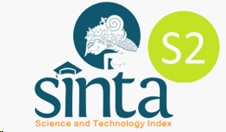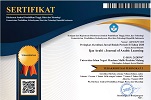Identification and Correction of Pseudowords in Ilman wa ruhan Textbooks to Reduce Meaning Errors
Abstract
The existence of pseudo-words in textbooks is a serious problem and requires special attention. This will certainly have a negative impact on the quality of learning and the achievement of educational goals. This research aims to reveal teaching materials that are pseudo and provide corrections to these materials so that they become more meaningful and useful for learners. This paper uses an adaptation of the qualitative content analysis method, namely identifying, and classifying. The data was obtained through direct observation of Ilman wa ruhan volume one and two textbooks that enter the word learning process. The observation instrument of this research is maany digital dictionary which has been standardized internationally. The conclusion of this study shows the existence of pseudo-words in volume one and volume two textbooks in the early part of learning three connected letters. The research findings revealed the existence of 24 pseudo-words in the form of three kinds of criteria, namely the criteria for vocal incompatibility, consonant incompatibility criteria and writing incompatibility criteria. This study contributes to the correction of these pseudo-words so that the learners read and pronounce the correct language in Arabic and the Koran. This effort is expected to improve the quality of textbooks and support the creation of a meaningful learning process for students.
Keywords
Full Text:
PDFReferences
A.R., H. B., Muhammad Alfan, & Bambang Irawan. (2022). Analisis Buku Ajar Bahasa Arab Untuk MTs Kelas 7 Karya Hasan Saefullah. Shaut al Arabiyyah, 10(1), 115–121. https://doi.org/10.24252/saa.v10i1.26015 Ainin, M. (2019). Kesalahan Dalam Penyusunan Rencana Pembelajaran Bahasa Arab di Madrasah/Sekolah. Prosiding Konferensi Nasional Bahasa Arab V, 199–209. Amrulloh, M. A. (2015). Pada Buku Ajar Bahasa Arab. Al-Tadzkiyyah: Jurnal Pendidikan Islam, 6, 46–65. Badruttama, C. A. (2022). Implementasi Metode Terpadu Ilman Wa Ruuhan Terhadap Sistem Belajar Mengajar Al Qur’an di SDIT Permata Kraksaan Probolinggo. 3(360), 1. Baihaqi, M., Darmawan, C., Jundi, A., Mubarak, A., Arab, P. B., & Dakwah, M. (2023). Al-Ta'aruuf 'ala Al-Kalimaat Al-Zaa'ifah fi Al-Kitaab Al-madrasii "Iqra'" lil-Had min Al-Ma'aanii Al-Khaati'ah. Pertemuan Ilmiah Internasional Bahasa Arab (Pinba), 1450. Chuang, Y. Y., Vollmer, M. L., Shafaei-Bajestan, E., Gahl, S., Hendrix, P., & Baayen, R. H. (2021). Pseudoword or phonological processing - discussion section. Behavior Research Methods, 53(3), 945–976. Cunningham, A. J., Burgess, A. P., Witton, C., Talcott, J. B., & Shapiro, L. R. (2021). Dynamic relationships between phonological memory and reading: A five year longitudinal study from age 4 to 9. Developmental Science, 24(1), 1–18. https://doi.org/10.1111/desc.12986 De Rosa, M., Vignali, L., D’urso, A., Ktori, M., Bottini, R., & Crepaldi, D. (2024). Selective Neural Entrainment Reveals Hierarchical Tuning to Linguistic Regularities in Reading. Neurobiology of Language, 5(2), 528–552. https://doi.org/10.1162/nol_a_00145 Eva Shofiyatun Nisa, & Dewi Maharani. (2022). Pengaruh Metode Qira`ati Terhadap Kemampuan Membaca Al-Qur’an. Jurnal Qiroah, 12(1), 43–52. https://doi.org/10.33511/qiroah.v12n1.43-52 Hasbi, M. (2021). Pengembangan Bahan Ajar Bahasa Arab Berbasis Al-Quran Untuk Para Santri Program Tahfiz Murni Di Pondok Pesantren Tahfidz Al …. Hernández Blasi, C., Bjorklund, D. F., Agut, S., Lozano Nomdedeu, F., & Martínez, M. Á. (2024). Children’s evolved cues to promote caregiving: Are voices more powerful than thoughts in signaling young children’s attributes and needs to adults? Evolution and Human Behavior, 45(5). https://doi.org/10.1016/j.evolhumbehav.2024.106609 Hidayah, F. (2022). Analisis Kesalahan Bahasa (Tahlil al Akhta’) Buku Ajar Bahasa Arab Madrasah Ibtidaiyyah Kelas IV. Incare: International Journal of Educational Resources, 03(01), 111–123. Hidayat, F. (2017). Kajian Psikologi Pembelajaran Hafal Quran bagi Anak Usia Dini. Annual Conference on Islamic Early Childhood Education, 2, 83–94. Kelas, A., Terbitan, M. I., & Pendidikan, D. (2021). Kesalahan morfosintaksis pada buku ajar bahasa arab kelas 5 mi terbitan departemen pendidikan hidayatullah. 3(1), 1–5. Kraljević, J. K., Škorić, A. M., Štefanec, A., & Lenček, M. (2022). Jevčok, stanjak, vojge: pseudoword formation and their role in speech-language intervention. Suvremena Psihologija, 25(2), 109–123. https://doi.org/10.21465/2022-SP-252-01 Maghfi, N., & Ulfah. (2020). SELING Jurnal Program Studi PGRA MENINGKATKAN KEMAMPUAN BAHASA ANAK MELALUI MEDIA PAPAN PINTAR (SMART BOARD). SELING Jurnal Program Studi PGRA, 6(2), 157–170. Nawaz, S., Kennedy, G., Bailey, J., & Mead, C. (2020). Moments of confusion in simulation-based learning environments. Journal of Learning Analytics, 7(3), 118–137. https://doi.org/10.18608/JLA.2020.73.9 Nazilah, A., Afia, D., & A, S. H. (2023). Analisis Buku Ajar Bahasa Arab Kelas XII Madrasah Aliyah Berdasarkan KMA 183 Tahun 2019. Rausyan Fikri Journal of Islamic Studies, 1(1), 17–34. https://doi.org/10.62283/rijis.v1i1.1 Pierce, A. D., & Smith, P. W. (1981). Acoustics: An Introduction to Its Physical Principles and Applications . Physics Today, 34(12), 56–57. https://doi.org/10.1063/1.2914388 Ramah, S., & Rohman, M. (2018). Analisis Buku Ajar Bahasa Arab Madrasah Aliyah Kurikulum 2013. Arabiyatuna : Jurnal Bahasa Arab, 2(2), 141. https://doi.org/10.29240/jba.v2i2.552 Riham Lailatul Wachdah. (2020). Evaluasi Buku Ajar Bahasa Arab Kelas X Madrasah Aliyah: Pendekatan Saintifik Kurikulum 2013. Al-Ma’rifah, 17(1), 41–47. https://doi.org/10.21009/almakrifah.17.01.04 Rusdi, R. (2023). Inovasi Pembelajaran Kosakata (Mufradat) Bahasa Arab Berbasis Al-Quran. TANJAK : Journal of Education and Teaching, 4(1), 19–31. https://doi.org/10.35961/tanjak.v4i1.745 Saimima, M. S., & Kaplale, T. (2023). Manajemen Metode Terpadu ‘Ilman Wa Ruuhan Di Madrasah Ibtidaiyah Terpadu (MIT) As Salam Ambon. 9, 51–58. Sari, N. A., & Juanda, J. (2023). Pemerolehan Bahasa Pertama Anak Usia 1 Tahun 7 Bulan dalam Bidang Fonologi. PAUDIA : Jurnal Penelitian dalam Bidang Pendidikan Anak Usia Dini, 12(2), 317–327. https://doi.org/10.26877/paudia.v12i2.16135 Sembiring, R J B., Pranowo, P., & Rahardi, R. K. (2013). Belajar Bahasa Secara Holistik : Apakah Pandangan Murid? Jurnal Pendidikan Bahasa dan Sastra, 13(2), 102–117. https://doi.org/10.17509/bs Syaifuji, A., Istiqomah, I. N., & Alfan, M. (2021). Analisis Morfosintaksis Buku Ajar Digital Bahasa Arab Kelas X Madrasah Aliyah Kementerian Agama Tahun 2020. Jurnal Pendidikan: Teori, Penelitian, dan Pengembangan, 6(6), 901. https://doi.org/10.17977/jptpp.v6i6.14881 Takdir, T. (2020). Problematika pembelajaran bahasa Arab. Naskhi: Jurnal Kajian Pendidikan dan Bahasa Arab, 2(1), 40–58. Thorpe, S. (n.d.). 24-month-olds and above remember novel object names after a single learning event Corresponding author : 33(0), 1–12. Utami, R. L. (2020). Desain Kurikulum Bahasa Arab di Indonesia. EL-IBTIKAR: Jurnal Pendidikan Bahasa Arab, 9(1), 108. https://doi.org/10.24235/ibtikar.v9i1.6235 Villegas Molina, I., Montalvo, A., Zhong, S., Jordan, M., & Raj, A. G. S. (2024). Generation and Evaluation of a Culturally-Relevant CS1 Textbook for Latines using Large Language Models. Annual Conference on Innovation and Technology in Computer Science Education, ITiCSE, 1, 325–331. https://doi.org/10.1145/3649217.3653600 Widyana, R. (2017). Faktor-Faktor Kognitif Yang Menjadi Prediktor Keberhasilan Pembelajaran Membaca Awal. Journal of Chemical Information and Modeling, 8(9), 1–17. Zemni, B., Awwad, W., & Bounaas, C. (2020). Audiovisual translation and contextual dictionaries: An exploratory comparative study of reverso context and almaany uses. Asian EFL Journal, 27(5.1), 274–309. Zhao, J., Zhao, J., Quiroz, B., Dixon, L., & Joshi, R. (2016). Comparing Bilingual to Monolingual Learners on English Spelling: A Meta-analytic Review. Dyslexia, 22 3, 193–213. https://doi.org/10.1002/dys.1530
DOI: https://doi.org/10.18860/ijazarabi.v8i1.29122
Refbacks
- There are currently no refbacks.
Copyright (c) 2025 Ahmad Jundi
License URL: https://creativecommons.org/licenses/by-sa/4.0/












